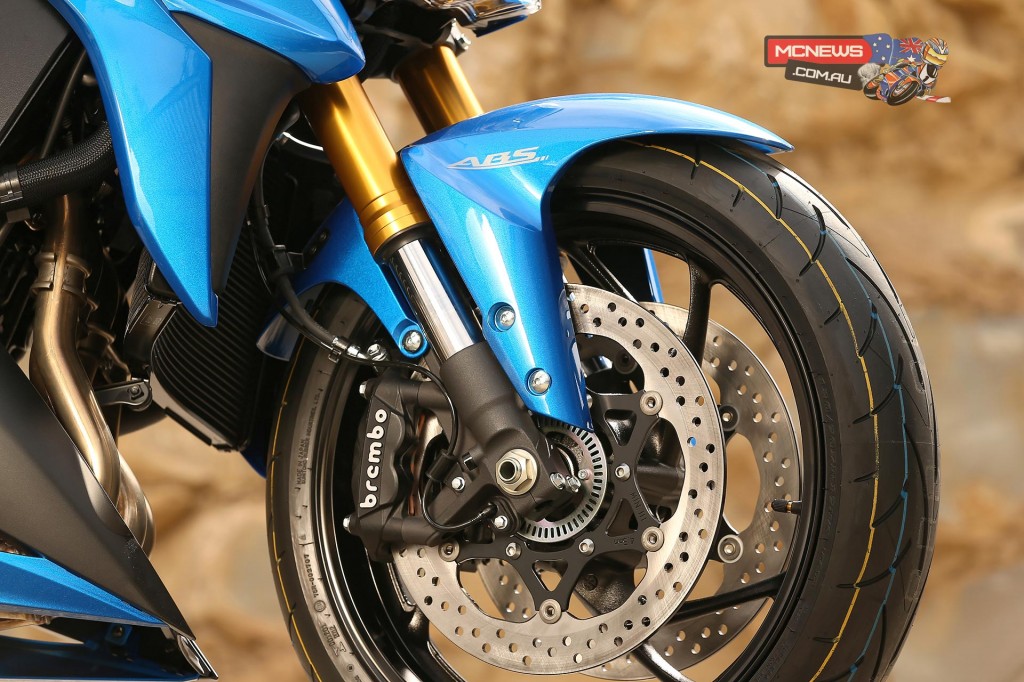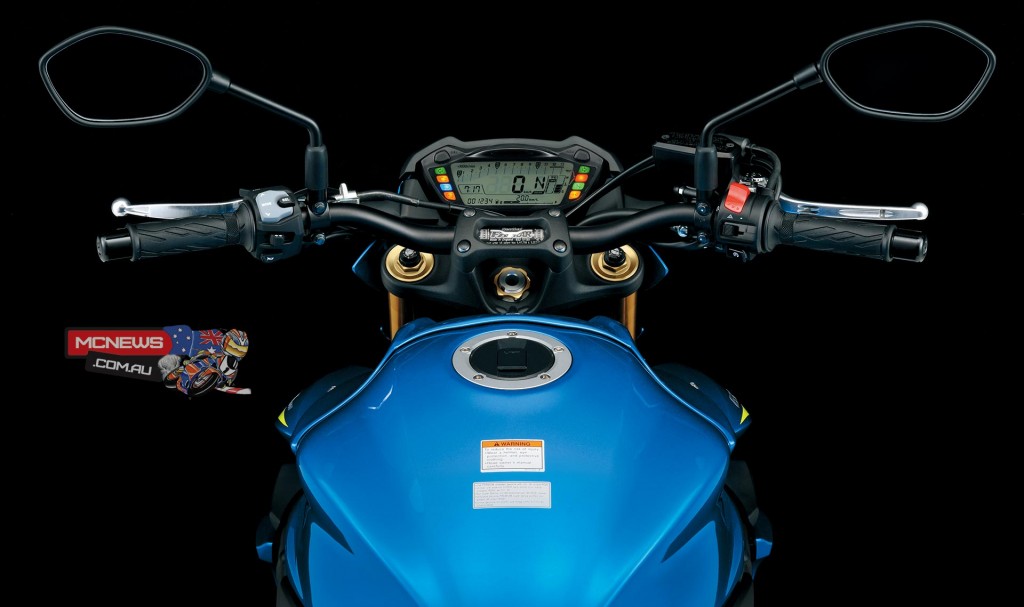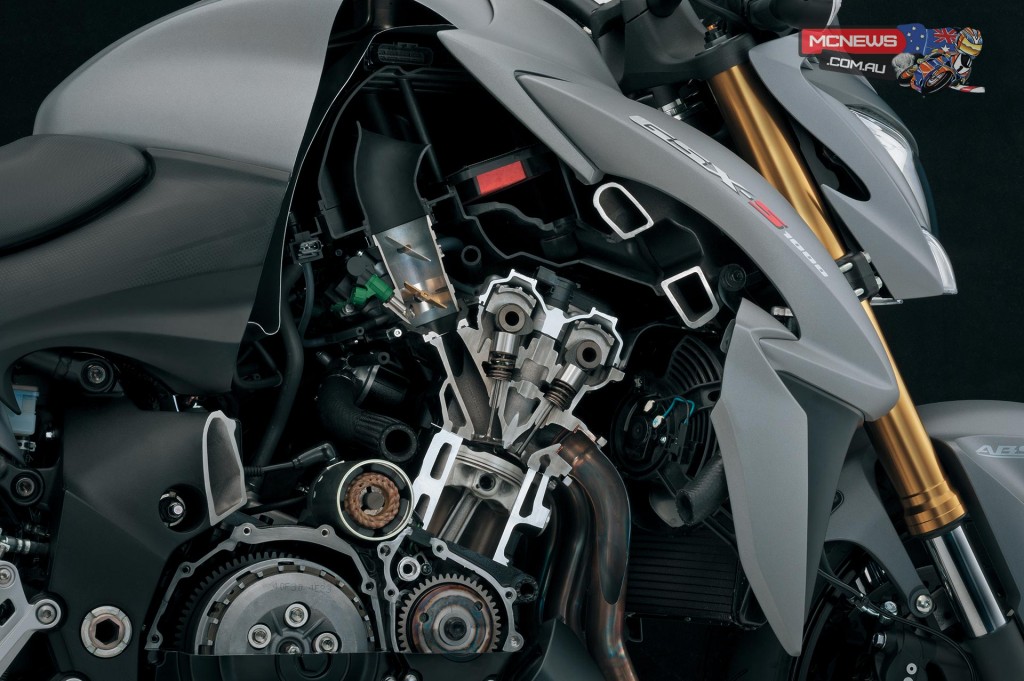The brakes are a good package. The test loop I’m on is perhaps one of the hardest tests of front brakes I’ve ever come across on the road. It’s a good 150km this section, of non-stop hard braking, hairpin after hairpin, a lot of it downhill – and the brakes do not fade at all, despite me squeezing them so hard I’m using the ABS almost every corner entry.
The brakes do lack some initial bite and they need a good, hard squeeze at the lever but this is a good setup for a nakedbike with road-based fork settings. Any sharper on the brakes would mean a change in those springs and settings.
The rear brake is great for cornering and I’m using it like a throttle for the tight parts as I carry some trailing throttle – due to the throttle snatch I mentioned earlier.

I’m not tiring at all on the GSX-S, despite the heavy braking and acceleration. The ride position allows me to really utilise my legs and the tank gives me support on the brakes, not to mention the big, wide Renthals.
The standard footpeg position suits me and I would not fit adjustable rearsets and the seat is comfy – no aches after five or six hours in the saddle…
After a quick lunch stop somewhere on the side of a mountain, I head off with the group, this time hoping for some bumps. So far the roads had been billiard table smooth and I know this is not what we have back home!
I get what I hope for and I’m soon screaming along flat-out on a bumpy, snotty goat track of a road. The GSX-S remains stable and composed but the suspension does not give the control that higher spec suspension would, however, I’m being fussy here. The shock is basic and there is some fade. I would not replace it if I owned a GSX-S – at least not until it is finished and needs replacing. If I was going to do some track days or sports touring, I would go for a higher quality aftermarket unit though. The forks are good without being fantastic. There is good support there on hard braking and good damping control – they just got a bit overworked on the fast, bumpy sections. I went up just two clicks of front compression during the test, to slow down initial dive on the anchors. I made no other changes to the settings of the GSX-S throughout the test loop.
On the fast, smooth sections as well as the slower stop/start smooth sections the suspension settles quickly and gives good support to the bike, no complaints there at all – it’s a good set-up.

The switchgear is easy to use and the traction control can be switched between the modes while riding. Once the mode is selected, it is confirmed the first time the throttle is closed fully.
The mirrors are very good, with minimal vibrations and the LCD dash is in the line of sight at a glance, however, I could not read the tacho numbers while riding, only the speed, TC setting number, trip, time and gear position.
It’s the little things that make riding the GSX-S so easy, like the sidestand – it naturally falls to foot when you want to flick it down to park – I didn’t even have to look down for it. The seat is wide enough to give support but narrow enough to aid sports riding. The fuel tank is quite big and tall, so it’s nice to rest an elbow on for some one-handed freeway cruising or just to chill out for a while – and there is no heat from the engine or exhaust to cook you while you ride. The GSX-S is not overly complicated – it’s got a throttle, brakes, handlebars and a strong engine. These things are the basics we all need to make us smile and I am still grinning thinking about the GSX-S1000.
There is a huge range of genuine accessories available for the bike – so personalising your own GSX-S would not be a problem…
I’ll have a red one thanks, with all the trick bits bolted on…

The GSX-S1000 powerplant has been refined and re-worked from the mighty K5 engine to compliment the new nakedbike. Basically, it is the same version of the 999cc 2005-2008 powerplant that got such a cult following, designed to give more acceleration and throttle response. The K5 engine was chosen as it has a long stroke for better mid range than the current GSX-R engine, because of its crank and gearbox layout permitting the desired frame design, and due to its proven reliability through multiple championships.
Bore and stroke remains 73.4 x 59mm, allowing for a compact combustion chamber and flat top pistons. This gives a broad spread of power throughout the rev range. The engine dimensions remain the same with cylinder pitch at 80mm and the same horizontally split crankcases and crank/input/output shaft layout. Cylinder angle is 23 degrees. There are some new parts – such as FEM (Finite Element Method) pistons that are three per cent lighter, helping with acceleration. The new camshafts are designed to optimize valve timing for the street, whereas the GSX-R1000 was tuned for the track. Iridium spark plugs heighten spark strength and therefore combustion efficiency, contributing to higher power, more linear throttle response, easier start-up and a more stable idle.
The cylinders are SCEM plated (Suzuki Composite Electrochemical Material) to improve heat transfer and durability. The compression ratio is 12.2:1 versus the GSX-R K5 ratio of 12.5:1 over the previous model’s (K4) 12.0:1. Valve size and port shape is unchanged.
The gearbox remains as per the GSX-R1000 and the back torque limiting clutch is also retained.
GSX-R1000 K7 44mm throttle-bodies are used, utilising the SDTV (Suzuki Dual Throttle Valve) system, where the secondary valves are servo controlled. The injectors are 10-hole long-nose units. The airbox is all-new, as is the exhaust system, which features equaliser pipes between cylinders one and four and, two and three. The catalytic converter is at the header collector box, which then joins the large volume exhaust chamber. The stubby muffler features a flapper valve, or SET (Suzuki Exhaust Tuning) system. Throttle position, gear position and engine rpm determine the opening of the servomotor driven valve, controlling pressure waves for optimum performance.
A highly efficient radiator keeps the engine cool, as does a newly designed liquid-cooled oil cooler.
Continue to page four using buttons below























